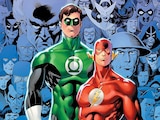C'mon, by now, you know who the Teen Titans are. In fact, depending on how old you are, there's actually a pretty good chance you were able to name any Teen Titans roster before you could count off the original seven members of the Justice League…and there's a good reason for that. Next to the League, the Titans are one of the most frequently adapted superteams in the DC Universe. Between all of their different ongoing comics, to their two highly success (and highly different) animated series, to their live action, DC Universe series, Titans, they've become ubiquitous across pop culture. They’re nothing less than the gold standard when talking about teenage superheroes coming of age.
But that wasn't always the case. The real revolution for the Teen Titans and their stake in the world today arrived during the 1980s with two legendary creators sitting at the helm: Marv Wolfman and George Perez. Together, they kicked off a new Titans era—one that we're still reaping the benefits of today. We recently sat down with Wolfman and Perez to take a look back at their NEW TEEN TITANS days, and to get their unique perspective on just where that staying power came from.

The most obvious updates to Titans history during the Wolfman/Perez era had to be the new characters they added to the lineup. In their original incarnation back in the 1960s, the team was comprised of familiar faces like Robin, Kid Flash and Wonder Girl, it wasn't until the New Teen Titans launch in 1980 that characters like Raven, Starfire and Cyborg got added to the mix.
But getting the newbies to really stick in the minds of fans wasn't as simple as dropping them into their own stories and leaving them be.
"I think to make them the Teen Titans, the smart move was having the established characters in there,” Perez elaborated on the delicate process. “It provided the continuity it would have lacked otherwise if you just created these totally new characters. You can concentrate on doing the new stories with these new characters but with the anchor and the familiarity that the fans can grab on to with characters like Robin, who was the first sidekick, Kid Flash, and Wonder Girl, who was supposed to be Wonder Woman's sidekick before that all got kind of messed up. The new characters provided fresh new material, but the whole idea of the sidekicks coming of age and growing out of their roles, that's why you needed the originals there."

Of course, Raven, Starfire and Cyborg were more than just "extras" in the ongoing saga of characters that had existed together for nearly twenty years before Perez and Wolfman had their run. As Perez made clear, they provided all kinds of new roads for Teen Titans stories to travel.
"We could still do stories about the coming of age of characters that had been established as the wards and sidekicks of senior characters,” he said, “but also do new stories that could range from mysterious gothic horror for Raven, sci-fi outer space stories for Starfire, gritty urban stories with a sci-fi twist for Cyborg. It allowed so much freedom."
Adding new angles to the Teen Titans formula was certainly one part of the update's success, but considering the real-life passage of time was another. The original team was designed for young kids, usually in the pre-teen demographic, and those stories didn't necessarily stay topical for very long as the years marched on. As Wolfman explained, the New Teen Titans added to their staying power by upping the ages of its members.

"One of the things I think was important was that the original Teen Titans all felt like they were 12 to 14,” he elaborated. “Our characters, for the most part, all were 17 to 19, and when you start with a point of view that the characters are that age, you're talking about people who back then could have been drafted. These 18- and 19-year-olds could have been drafted. That's when you get your car license. That's when you become an adult. You can get married, you can do all that stuff."
But maybe the most surprising key to the New Teen Titans success came from an unexpected quarter. Perez laughed as he credited the stories and the characters’ reprint value to one very specific decision on Wolfman's part.
"He didn't fall into the same trap that a lot of adults writing teenage characters do where they try to use the vernacular of the day—'teen speak’—which dates the characters instantly. The Titans have a certain timelessness to them. They can be teenagers and can remain teenagers now as much as they were teens in the 1980s without sounding off."
In fact, these days the Titans are able to adapt to all kinds of different voices, from the drama of Young Justice to the humor of Teen Titans Go! without sounding at all "off." Their universality has cemented itself over the last twenty years in such a way that they've become just as timeless as their League counterparts. Thanks to the foundation laid by Wolfman and Perez's revolutionary updates, that timelessness isn't going anywhere any time soon.
Marv Wolfman and George Perez’s legendary NEW TEEN TITANS run is now available as a series of graphic novels in print and as a digital download.
Titans has its World Premiere tonight at New York Comic Con in the Hammerstein Ballroom. Not going to be there? Catch its debut on October 12th on DC Universe!















